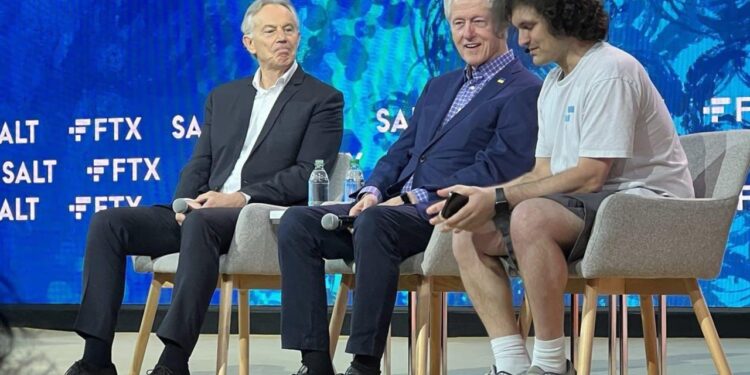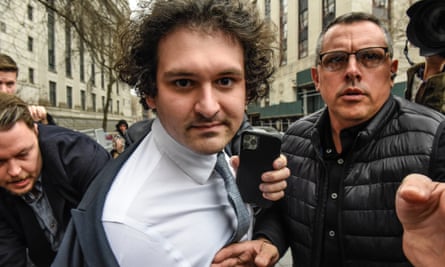If the high-rollers surrounding the disgraced FTX founder had any qualms about taking his money, they didn’t show it
Later today, a man who has recently turned 32 will be hauled in front of a Manhattan judge. Already convicted of huge fraud, he knows he’s going to prison. The only question is for how long. If the US government gets its way, he will not emerge before his 80th birthday.
This is the final disgrace of Sam Bankman-Fried. The judge, politicians and the world’s press will declare him one of the biggest swindlers in American history. They will note how within three years he built a marketplace for digital currencies, or crypto, that was worth around $32bn – and made himself the world’s richest person under 30. Still it wasn’t enough. He spent perhaps $8bn of his customers’ savings on luxury homes, risky investments and whatever else took his fancy.
But remember this. Those same groups who today come to bury the boy billionaire yesterday praised him without qualification – and took as much of his cash as they could. While battling Donald Trump in 2020, Joe Biden received about $5m from Bankman-Fried. He wasn’t alone. Mitt Romney, Cory Booker, Paul Ryan, Nancy Pelosi: they and so many other Democrats and Republicans accepted collectively tens of millions.
Also on the payroll to endorse Bankman-Fried’s trading exchange, FTX, were celebrities and sports stars, from Larry David (who got a reported $10m to make one ad) to Gisele Bündchen and her then partner, the quarterback Tom Brady, the tennis player Naomi Osaka and the basketball legend Shaquille O’Neal. If these high-rollers had the faintest qualm about taking huge sums from a young man who had dropped out of nowhere to head a business based in a tax haven, they didn’t let it stop them taking his dollars.
Less than a minute on Google will show you photos of Tony Blair and Bill Clinton at a conference organised by Bankman-Fried. At his invitation, the two statesmen had flown to the financiers’ paradise of the Bahamas; there they sit, stiffly onstage in dark suits while the prodigy slouches in a grubby T-shirt and shorts. He may be less than half their age, but there is no doubt who’s in charge, or who’s picking up the tab. It was spring 2022, only months before Bankman-Fried was arrested and extradited back to the US.
Up until then, the billionaire dined with Jeff Bezos and Leonardo DiCaprio. He hobnobbed with pop stars. Upon meeting, Katy Perry posted on Instagram: “im quitting music and becoming an intern for @ftx_official ok.” He was hosannaed on the covers of business magazines and a regular on American TV. The profiles depicted him as an idiot savant who slept next to his desk on a beanbag and worked amid day-old containers of chickpea korma.
Less space was devoted to the $40m penthouse in which he actually lived, looking out on to a yacht-filled marina, or to his upbringing as the son of two Stanford Law professors, who’d sent him to private school before the Massachusetts Institute of Technology. Who wanted dreary old facts when you could have the American dream?
After he was arrested and his bail was set at an almost-impossible $250m, they managed to raise the funds. Far too much was made of how he was amassing this fortune only to give it away, following a philosophy dubbed effective altruism. One journalist was savvy enough to do the maths and point out: “So far he’s donated less to charity than he’s spent on naming rights for the Miami Heat’s arena.”
More than hypocrisy by people who just wanted their next pay cheque, it helped to create his fortune. Among those who plunged millions into FTX were some of the biggest names in finance. One, a Silicon Valley firm called Sequoia Capital, not only gave its money: it ran a near-14,000 word hagiography of Bankman-Fried. When things went south a few weeks later, the piece was taken down. But with typical generosity, the web has archived it. Among the highlights is how Sequoia’s partners met Bankman-Fried over Zoom. They asked how he saw the future of FTX.
Rather than focus on the interview, Bankman-Fried is playing a video game, notes the piece. He says laconically: “I want FTX to be a place where you can do anything you want with your next dollar. You can buy bitcoin. You can send money in whatever currency to any friend anywhere in the world. You can buy a banana.”
Then, the piece records: “Suddenly, the chat window on Sequoia’s side of the Zoom lights up with partners freaking out.”
“I LOVE THIS FOUNDER,” typed one partner … “YES!!!” exclaimed a second.
Another responded excitedly: “I am a 10 out of 10.”
A pudding-faced boy in baggy shorts says he wants to buy a banana with internet money and some of the greatest minds in finance go wild. Just remember: it is this same class of geniuses in bodywarmers who Keir Starmer and Rachel Reeves believe will finance our new green industries.
If in these stories you can hear echoes of Jay Gatsby, that is no accident. The Great Gatsby was published in 1925, amid one of the great financial bubbles in world history. Wall Street went bust in 1929, and when the economist John Kenneth Galbraith wrote his masterful history The Great Crash, 1929, he diagnosed how economically exuberant societies indulged the same financial crimes they would later drag into court. He called this “the bezzle”.
“In good times people are relaxed, trusting, and money is plentiful,” he wrote. “But even though money is plentiful, there are always many people who need more. Under these circumstances the rate of embezzlement grows, the rate of discovery falls off, and the bezzle increases rapidly.”
When the crash comes, everything changes. “Money is watched with a narrow, suspicious eye. The man who handles it is assumed to be dishonest until he proves himself otherwise … The bezzle shrinks.”
As Galbraith makes clear, financial crimes aren’t purveyed only by evil masterminds. They are licensed by entire societies who believe in them – until they don’t. Bankman-Fried’s great fall from disgrace began shortly after US interest rates began marching upwards, in the summer of 2022.
In many ways, his story is of how an entire decade of cheap money and high hopes for a new economic paradigm was squandered. His crimes are his own to atone for. But his disgrace is the disgrace of a much larger financial and political establishment. The old guard spent years waiting for a new saviour to come along and rescue them from the doldrums of the banking crash. When a boy pulled up in a battered Corolla, they got in without asking too many questions.
Source: The Guardian




Recent Comments